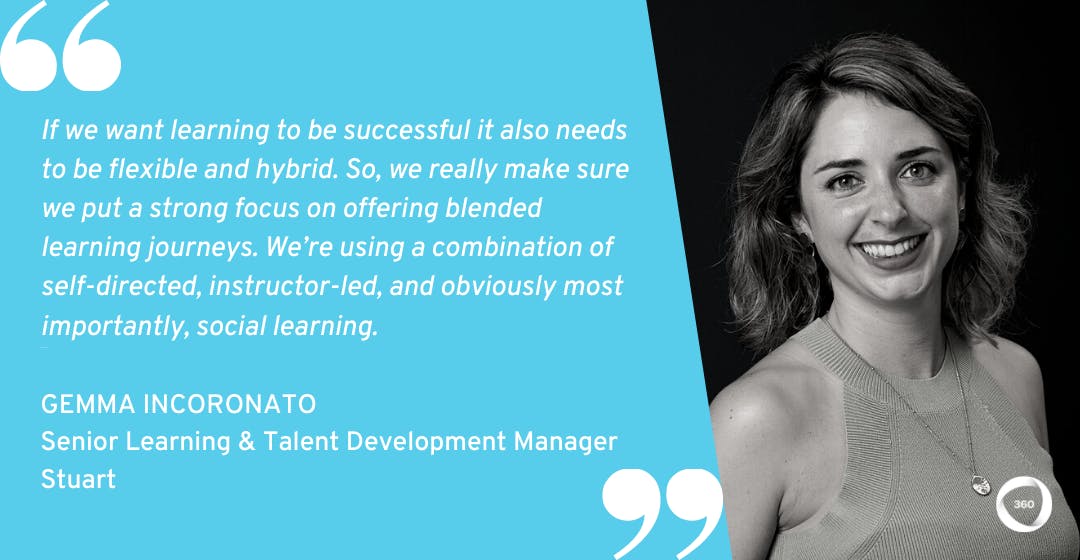
Delivering Closer Connections: Stuart’s 3-Part Strategy for Flexible Hybrid Learning
Today, working and learning doesn’t just happen in one place. With more organizations switching to models of hybrid and remote work, teams are spread out across cities, countries, and time zones.
This creates new opportunities for people to live and work where they want, but it also leads to a huge challenge for L&D teams. So, how can you build innovative and collaborative learning programs that bring people together no matter where they are?
Fortunately for us, Gemma Incoronato, Senior Learning & Talent Development Manager at Stuart, has a plan. In my latest expert interview, Gemma told me about her three-part strategy for delivering closer connections between learners through communicating between teams, departments, and countries.
Read on to hear why communication and collaboration are both so important for an on-demand logistics platform company like Stuart.
Loving what you’re reading? Come and join the L&D Collective for more great learning insights, resources, and events!
The learning challenge of flexible hybrid work
As a B2B platform helping businesses to offer better delivery options to their customers, Stuart operates in 150 cities in six countries. As Gemma explains, this geographical spread has big implications for how Stuart employees work.
“One of our core missions is to create logistics for a sustainable world, and we're really focusing on reducing carbon emissions,” says Gemma. “Recently, we went through a super cool hypergrowth phase, and we're now a company of 700 people in seven European offices.”
Like so many other organizations, Stuart has adopted a model of flexible hybrid work. As Gemma notes, on one hand, this is fantastic because it gives the employee a variety of options for the ways of working.
“But this model of flexible hybrid work also brings challenges when it comes to cross-team, cross-department, cross-functional, and cross-country collaboration. One of our company OKRs this year is to build a world-class team. As part of the people function, we're really focusing on increasing that communication.”
But what is Gemma’s learning strategy for increasing communication and collaboration in a flexible hybrid working environment? Read on to hear about her three-part strategy.
Looking for better ways to engage your teams from a distance? Check out our 5 tips for better engagement in the world of hybrid work.

Get your copy of our team engagement cheatsheet
By providing your contact info, you agree to receive communications from 360Learning. You can opt-out at any time. For details, refer to our Privacy Policy.
This model of flexible hybrid work also brings challenges when it comes to cross-team, cross-department, cross-functional, and cross-country collaboration.
Stuart’s 3-part strategy for delivering flexible hybrid learning
Stuart’s learning and talent development department, known internally as the Stuart Academy, is built with a strong focus on three Cs: Connect, Communicate, and Collaborate.
“If we want learning to be successful it also needs to be flexible and hybrid,” Gemma explains. “So, we really make sure we put a strong focus on offering blended learning journeys. We’re using a combination of self-directed, instructor-led, and obviously most importantly, social learning.”

So, what was Gemma’s first step towards delivering this learning in a hybrid environment? First, she implemented a mentoring program to bring people together.
1. Bring people together through mentoring
One of the offerings within their Stuart Academy, Gemma explains, is their mentorship program which had over 100 ‘Stuees’ sign up as mentors and mentees last year.
“We played Cupid,” says Gemma. “We paired people up depending on their needs, the core competency they're wanting to develop, and their level. So the mentors were supporting the mentees and developing either specific technical skills or soft skills.”
The main objective of the program was to bring Stuees together through learning. Gemma and her team offered kick-off sessions and the chance for mentors and mentees to share previous mentorship experiences, what they learned, and some best practices.
“The beautiful thing was we had a celebration ceremony where even our CEO Damien–who is a really amazing great sponsor and advocate for learning–joined not only to listen to Stuees share the impact the program had on them but also to highlight that value of continuously building a learning culture through collaboration.”
As Gemma explains, this collaboration is helping Stuart become more innovative together as well as building their core competency of teamwork. “Through programs like this, we really get to embody our focus on meaningful collaboration.”
Next up, Gemma and the team focused on building closer relationships between different departments and scopes.
Related: How VNA Health Group Welcomes New Nurses with a Targeted Peer-to-Peer Residency Program
2. Build relationships between different departments and scopes
The second program within Stuart’s collaborative pillar is their ambassador program which allows Stuees to get involved in activities outside of the scope of their normal role and build relationships with peers.
“We have initiatives such as leading a Stu-Talk, where Stuees teach Stuees,” explains Gemma. “So, once a month we have any Stuee create and deliver a presentation or a class to share business-related knowledge with the whole company.”
But as Gemma notes, inside the ambassador program, Stuees can also get points for being an onboarding buddy. “Even joining a coffee roulette to talk with someone outside of your department, becoming a mentor, or getting involved in local committees.”
“So once they reach a certain number of points, they can get prizes and they will be recognized and rewarded as ambassadors or stewards.”
Finally, Gemma and the team focused on cultivating communication through solving shared challenges.
Once a month we have any Stuee create and deliver a presentation or a class to share business-related knowledge with the whole company.
3. Cultivate communication through solving shared challenges
Stuart’s third program was designed to meet the OKR of building a world-class team and increase cross-department, cross-country, and functional collaboration.
“We created this program in partnership with a company called AV Academy. We're rolling it out to all Stuees on a monthly basis to help us overcome the challenge of connecting and collaborating together within our cross-country hybrid working model.”
For Gemma and the team, this program has helped to build peer relationships and foster communication and collaboration through engaging and collaborative experiences.
“The AV Academy uses a combination of learning design, including facilitating using Miro boards. This makes it really fun, as well as bringing in our values at Stuart around communication and collaboration. It’s what makes us a little bit different.”
“We intentionally tried to split learners up into diverse groups, with a strong emphasis on creating spaces for them to spend time together in breakout rooms to really actually connect. We wanted people to discuss the current challenges they may be facing regarding communication and collaboration.”
In Gemma’s experience, the breakout rooms allowed people to identify different communication and working styles. “You may have some people who are more drivers, more harmonizers, more analytical mindsets, and this is what can sometimes cause a clash and a misunderstanding which drives conflict.”
“So, we also talk about things like: what's your conflict style? What are our unconscious biases? We touch on a lot of different subjects, and the feedback we've gotten already is amazing.”
Stuart’s cultivating communication program highlights the advantages of collaborative learning. By building engaging and collaborative experiences for Stuees, Gemma and the team helped build closer connections within their global organization.
So, that’s Gemma’s three-part strategy for flexible hybrid learning. But how does she know they’re having the right impact?
Related: Now Is Our Only Chance to Fix Remote Work— Here's How We're Doing It
We intentionally tried to split learners up into diverse groups, with a strong emphasis on creating spaces for them to spend time together in breakout rooms to really actually connect.
Measuring the impact of Stuart’s hybrid learning model
Gemma and her team are using a global engagement survey and drivers directly related to peer relationships to measure the impact of their approach. But with Stuart being such a melting pot of different cultures, her main focus is on having those conversations and allowing space to talk and build trust between teams.
“In our global engagement surveys, we’re asking questions specifically on how people are developing peer relationships. That's where we will really be able to see the impact that we will have had.”
As Gemma explains, designing a learning strategy for hybrid environments involves starting with one key question: what kinds of resources can you bring to the table?
Related: 3 Data-Based Ways To Prove Training ROI (+ Free Training ROI Calculator)
In our global engagement surveys, we’re asking questions specifically on how people are developing peer relationships.
Roundtables are great for boosting learner connections
In Gemma’s experience, keeping learners connected in hybrid environments depends a lot on the resources you have. “Each of these learning programs is a lot of time, a lot of energy, and a lot of effort.”
“Right now, we're implementing an LMS as well to automate and digitalize our offerings and be able to have more automated reports. So, if you have something like that in place, that's going to help bring these collaborative learning initiatives into place.”
As Gemma notes, it also depends on your learning culture at your company and listening directly to employees about what they want and need–and this doesn’t have to be complicated. “One simple step is to start learning roundtables, which does not require a lot of work because it is the employees teaching and leading the classes.”
For example, Stuart is offering for learners to take a specific course, after which everyone gets together for a ‘lunch and learn’ roundtable to share their takeaways from their courses. “With this, you don't need to be the expert. It’s just about offering that space for one another to bring their own experiences to the table.”
One simple step is to start learning roundtables, which does not require a lot of work because it is the employees teaching and leading the classes.
Thanks to Gemma for sharing her hybrid learning experience and insights with us!
For more advice on how to connect your learners from a distance, check out our interviews with Halimah Jones of Slack on building new hire communities through remote onboarding, and with Felicia White of Church’s Chicken on achieving 93% training completions during the COVID-19 pandemic.
Want more peer insights on transforming workplace learning? Sign up to become a member of the L&D Collective, and check out our other #CLOConnect interviews with top L&D leaders on driving growth and scaling culture through Collaborative Learning. Or you can subscribe (below 👇) to our weekly newsletter to receive our latest posts directly in your inbox.

